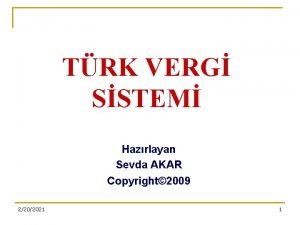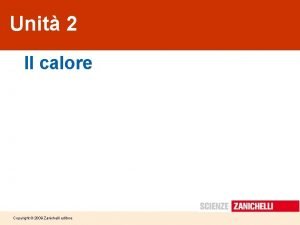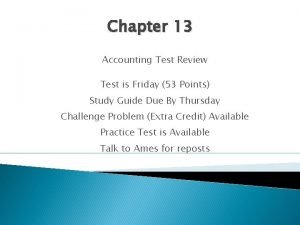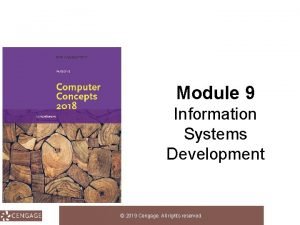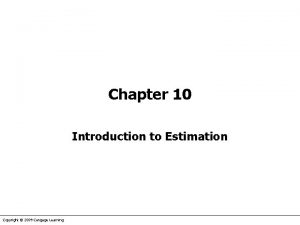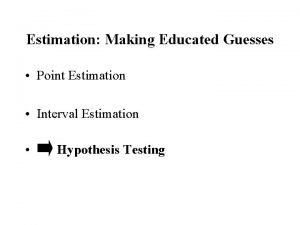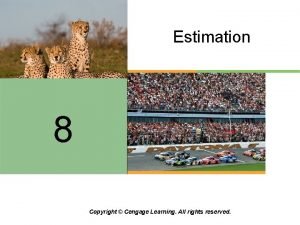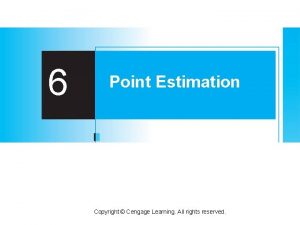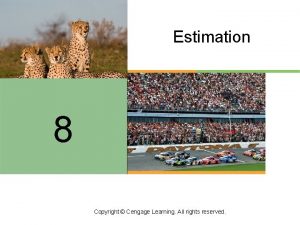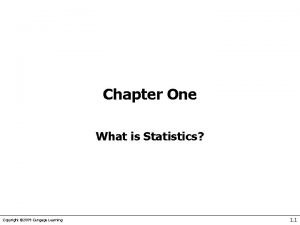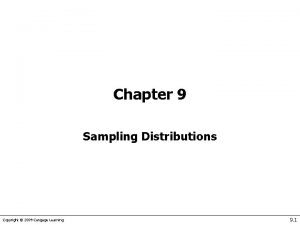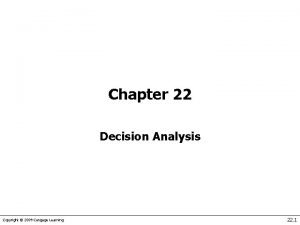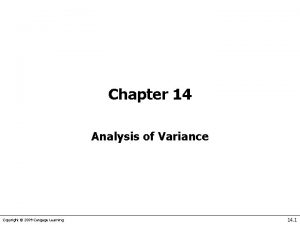Chapter 10 Introduction to Estimation Copyright 2009 Cengage











































- Slides: 43

Chapter 10 Introduction to Estimation Copyright © 2009 Cengage Learning

Where we have been… Chapter 7 and 8: Binomial, Poisson, normal, and exponential distributions allow us to make probability statements about X (a member of the population). To do so we need the population parameters. Binomial: p Poisson: µ Normal: µ and σ Exponential: λ or µ Copyright © 2009 Cengage Learning

Where we have been… Chapter 9: Sampling distributions allow us to make probability statements about statistics. We need the population parameters. Sample mean: µ and σ Sample proportion: p Difference between sample means: µ 1, σ1 , µ 2, and σ2 Copyright © 2009 Cengage Learning

Where we are going… However, in almost all realistic situations parameters are unknown. We will use the sampling distribution to draw inferences about the unknown population parameters. Copyright © 2009 Cengage Learning

Statistical Inference… Statistical inference is the process by which we acquire information and draw conclusions about populations from samples. In order to do inference, we require the skills and knowledge of descriptive statistics, probability distributions, and sampling distributions. Copyright © 2009 Cengage Learning

Estimation… There are two types of inference: estimation and hypothesis testing; estimation is introduced first. The objective of estimation is to determine the approximate value of a population parameter on the basis of a sample statistic. E. g. , the sample mean ( population mean ( ). Copyright © 2009 Cengage Learning ) is employed to estimate the

Estimation… The objective of estimation is to determine the approximate value of a population parameter on the basis of a sample statistic. There are two types of estimators: Point Estimator Interval Estimator Copyright © 2009 Cengage Learning

Point Estimator… A point estimator draws inferences about a population by estimating the value of an unknown parameter using a single value or point. We saw earlier that point probabilities in continuous distributions were virtually zero. Likewise, we’d expect that the point estimator gets closer to the parameter value with an increased sample size, but point estimators don’t reflect the effects of larger sample sizes. Hence we will employ the interval estimator to estimate population parameters… Copyright © 2009 Cengage Learning

Interval Estimator… An interval estimator draws inferences about a population by estimating the value of an unknown parameter using an interval. That is we say (with some ___% certainty) that the population parameter of interest is between some lower and upper bounds. Copyright © 2009 Cengage Learning

Point & Interval Estimation… For example, suppose we want to estimate the mean summer income of a class of business students. For n = 25 students, is calculated to be 400 $/week. point estimate interval estimate An alternative statement is: The mean income is between 380 and 420 $/week. Copyright © 2009 Cengage Learning

Qualities of Estimators… Qualities desirable in estimators include unbiasedness, consistency, and relative efficiency: An unbiased estimator of a population parameter is an estimator whose expected value is equal to that parameter. An unbiased estimator is said to be consistent if the difference between the estimator and the parameter grows smaller as the sample size grows larger. If there are two unbiased estimators of a parameter, the one whose variance is smaller is said to be relatively efficient. Copyright © 2009 Cengage Learning

Unbiased Estimators… An unbiased estimator of a population parameter is an estimator whose expected value is equal to that parameter. E. g. the sample mean X is an unbiased estimator of the population mean µ , since: E(X) = µ Copyright © 2009 Cengage Learning

Unbiased Estimators… An unbiased estimator of a population parameter is an estimator whose expected value is equal to that parameter. E. g. the sample median is an unbiased estimator of the population mean µ since: E(Sample median) = µ Copyright © 2009 Cengage Learning

Consistency… An unbiased estimator is said to be consistent if the difference between the estimator and the parameter grows smaller as the sample size grows larger. E. g. X is a consistent estimator of µ because: V(X) is σ2/n That is, as n grows larger, the variance of X grows smaller. Copyright © 2009 Cengage Learning

Consistency… An unbiased estimator is said to be consistent if the difference between the estimator and the parameter grows smaller as the sample size grows larger. E. g. Sample median is a consistent estimator of µ because: V(Sample median) is 1. 57σ2/n That is, as n grows larger, the variance of the sample median grows smaller. Copyright © 2009 Cengage Learning

Relative Efficiency… If there are two unbiased estimators of a parameter, the one whose variance is smaller is said to be relatively efficient. E. g. both the sample median and sample mean are unbiased estimators of the population mean, however, the sample median has a greater variance than the sample mean, so we choose since it is relatively efficient when compared to the sample median. Thus, the sample mean population mean µ. Copyright © 2009 Cengage Learning is the “best” estimator of a

Estimating when is known… In Chapter 8 we produced the following general probability statement about And from Chapter 9 the sampling distribution of is approximately normal with mean µ and standard deviation Thus is (approximately) standard normally distributed. Copyright © 2009 Cengage Learning

Estimating when is known… Thus, substituting Z we produce In Chapter 9 (with a little bit of algebra) we expressed the following With a little bit of different algebra we have Copyright © 2009 Cengage Learning

Estimating µ when σ is known… This is still a probability statement about However, the statement is also a confidence interval estimator of µ Copyright © 2009 Cengage Learning

Estimating when is known… The interval can also be expressed as Lower confidence limit = Upper confidence limit = The probability 1 – α is the confidence level, which is a measure of how frequently the interval will actually include µ. Copyright © 2009 Cengage Learning

Example 10. 1… The Doll Computer Company makes its own computers and delivers them directly to customers who order them via the Internet. To achieve its objective of speed, Doll makes each of its five most popular computers and transports them to warehouses from which it generally takes 1 day to deliver a computer to the customer. This strategy requires high levels of inventory that add considerably to the cost. Copyright © 2009 Cengage Learning

Example 10. 1… To lower these costs the operations manager wants to use an inventory model. He notes demand during lead time is normally distributed and he needs to know the mean to compute the optimum inventory level. He observes 25 lead time periods and records the demand during each period. Xm 10 -01 The manager would like a 95% confidence interval estimate of the mean demand during lead time. Assume that the manager knows that the standard deviation is 75 computers. Copyright © 2009 Cengage Learning

Example 10. 1… Copyright © 2009 Cengage Learning

Example 10. 1… “We want to estimate the mean demand over lead time with 95% confidence in order to set inventory levels…” IDENTIFY Thus, the parameter to be estimated is the population mean: µ And so our confidence interval estimator will be: Copyright © 2009 Cengage Learning

Example 10. 1… COMPUTE In order to use our confidence interval estimator, we need the following pieces of data: 370. 16 Calculated from the data… 1. 96 75 n Given 25 therefore: The lower and upper confidence limits are 340. 76 and 399. 56. Copyright © 2009 Cengage Learning

Example 10. 1 Using Excel COMPUTE By using the Data Analysis Plus™ toolset, on the Xm 10 -01 file, we get the same answer with less effort… Click Add-In > Data Analysis Plus > Z-Estimate: Mean Copyright © 2009 Cengage Learning

Example 10. 1 Copyright © 2009 Cengage Learning

Example 10. 1… INTERPRET The estimation for the mean demand during lead time lies between 340. 76 and 399. 56 — we can use this as input in developing an inventory policy. That is, we estimated that the mean demand during lead time falls between 340. 76 and 399. 56, and this type of estimator is correct 95% of the time. That also means that 5% of the time the estimator will be incorrect. Incidentally, the media often refer to the 95% figure as “ 19 times out of 20, ” which emphasizes the long-run aspect of the confidence level. Copyright © 2009 Cengage Learning

Interpreting the confidence Interval Estimator Some people erroneously interpret the confidence interval estimate in Example 10. 1 to mean that there is a 95% probability that the population mean lies between 340. 76 and 399. 56. This interpretation is wrong because it implies that the population mean is a variable about which we can make probability statements. In fact, the population mean is a fixed but unknown quantity. Consequently, we cannot interpret the confidence interval estimate of µ as a probability statement about µ. Copyright © 2009 Cengage Learning

Interpreting the confidence Interval Estimator To translate the confidence interval estimate properly, we must remember that the confidence interval estimator was derived from the sampling distribution of the sample mean. We used the sampling distribution to make probability statements about the sample mean. Although the form has changed, the confidence interval estimator is also a probability statement about the sample mean. Copyright © 2009 Cengage Learning

Interpreting the confidence Interval Estimator It states that there is 1 - α probability that the sample mean will be equal to a value such that the interval to will include the population mean. Once the sample mean is computed, the interval acts as the lower and upper limits of the interval estimate of the population mean. Copyright © 2009 Cengage Learning

Interpreting the Confidence Interval Estimator As an illustration, suppose we want to estimate the mean value of the distribution resulting from the throw of a fair die. Because we know the distribution, we also know that µ = 3. 5 and σ = 1. 71. Pretend now that we know only that σ = 1. 71, that µ is unknown, and that we want to estimate its value. To estimate , we draw a sample of size n = 100 and calculate. The confidence interval estimator of is Copyright © 2009 Cengage Learning

Interpreting the Confidence Interval Estimator The 90% confidence interval estimator is Copyright © 2009 Cengage Learning

Interpreting the Confidence Interval Estimator This notation means that, if we repeatedly draw samples of size 100 from this population, 90% of the values of will be such that µ would lie somewhere and that 10% of the values of include µ. will produce intervals that would not Now, imagine that we draw 40 samples of 100 observations each. The values of and the resulting confidence interval estimates of are shown in Table 10. 2. Copyright © 2009 Cengage Learning

Interval Width… A wide interval provides little information. For example, suppose we estimate with 95% confidence that an accountant’s average starting salary is between $15, 000 and $100, 000. Contrast this with: a 95% confidence interval estimate of starting salaries between $42, 000 and $45, 000. The second estimate is much narrower, providing accounting students more precise information about starting salaries. Copyright © 2009 Cengage Learning

Interval Width… The width of the confidence interval estimate is a function of the confidence level, the population standard deviation, and the sample size… Copyright © 2009 Cengage Learning

Interval Width… The width of the confidence interval estimate is a function of the confidence level, the population standard deviation, and the sample size… A larger confidence level produces a w i d e r confidence interval: Estimators. xls Copyright © 2009 Cengage Learning

Interval Width… The width of the confidence interval estimate is a function of the confidence level, the population standard deviation, and the sample size… Larger values of σ produce w i d e r confidence intervals Estimators. xls Copyright © 2009 Cengage Learning

Interval Width… The width of the confidence interval estimate is a function of the confidence level, the population standard deviation, and the sample size… Increasing the sample size decreases the width of the confidence interval while the confidence level can remain unchanged. Estimators. xls Note: this also increases the cost of obtaining additional data Copyright © 2009 Cengage Learning

Selecting the Sample Size… In Chapter 5 we pointed out that sampling error is the difference between an estimator and a parameter. We can also define this difference as the error of estimation. In this chapter this can be expressed as the difference between and µ. Copyright © 2009 Cengage Learning

Selecting the Sample Size… The bound on the error of estimation is B= With a little algebra we find the sample size to estimate a mean. Copyright © 2009 Cengage Learning

Selecting the Sample Size… To illustrate suppose that in Example 10. 1 before gathering the data the manager had decided that he needed to estimate the mean demand during lead time to with 16 units, which is the bound on the error of estimation. We also have 1 –α =. 95 and σ = 75. We calculate Copyright © 2009 Cengage Learning

Selecting the Sample Size… Because n must be an integer and because we want the bound on the error of estimation to be no more than 16 any non-integer value must be rounded up. Thus, the value of n is rounded to 85, which means that to be 95% confident that the error of estimation will be no larger than 16, we need to randomly sample 85 lead time intervals. Copyright © 2009 Cengage Learning
 Chapter 6:2 interpreting word parts
Chapter 6:2 interpreting word parts 2009 delmar cengage learning
2009 delmar cengage learning Learning exercises chapter 1 medical terminology
Learning exercises chapter 1 medical terminology Measuring and recording apical pulse
Measuring and recording apical pulse Chapter 6 the skeletal system answer key
Chapter 6 the skeletal system answer key Chapter 13 medical math
Chapter 13 medical math Chapter 10 cultural diversity
Chapter 10 cultural diversity Copyright cengage learning. powered by cognero
Copyright cengage learning. powered by cognero Copyright 2009
Copyright 2009 Copyright international color consortium, 2009
Copyright international color consortium, 2009 Dell all rights reserved copyright 2009
Dell all rights reserved copyright 2009 Copyright 2009 pearson education inc
Copyright 2009 pearson education inc Diffrazione zanichelli
Diffrazione zanichelli Copyright 2009
Copyright 2009 Conduzione convezione irraggiamento zanichelli
Conduzione convezione irraggiamento zanichelli Copyright 2009 pearson education inc
Copyright 2009 pearson education inc 2009 pearson education inc
2009 pearson education inc Copyright 2009 pearson education inc
Copyright 2009 pearson education inc Copyright 2009 pearson education inc
Copyright 2009 pearson education inc Cengage learning chapter 7 answers
Cengage learning chapter 7 answers Cengage chapter 7
Cengage chapter 7 Accounting chapter 13 test a answers
Accounting chapter 13 test a answers Medical terminology chapter 5 learning exercises answers
Medical terminology chapter 5 learning exercises answers Chapter 8 the digestive system labeling exercises
Chapter 8 the digestive system labeling exercises Knowledge of medical terminology
Knowledge of medical terminology Matching muscle directions and positions
Matching muscle directions and positions Cengage medical terminology chapter 1
Cengage medical terminology chapter 1 Cengage differential equations
Cengage differential equations Bank reconciliation cengage
Bank reconciliation cengage Cengage differential equations
Cengage differential equations Cengage learning heart diagram
Cengage learning heart diagram Cengage
Cengage Cengage
Cengage Cengage
Cengage South-western cengage learning
South-western cengage learning Cengage
Cengage Cengage
Cengage Cengage
Cengage Cengage learning heart diagram
Cengage learning heart diagram Cengage learning australia
Cengage learning australia Whille
Whille Cengage learning
Cengage learning Module 1 computer concepts exam cengage
Module 1 computer concepts exam cengage Cengage
Cengage













